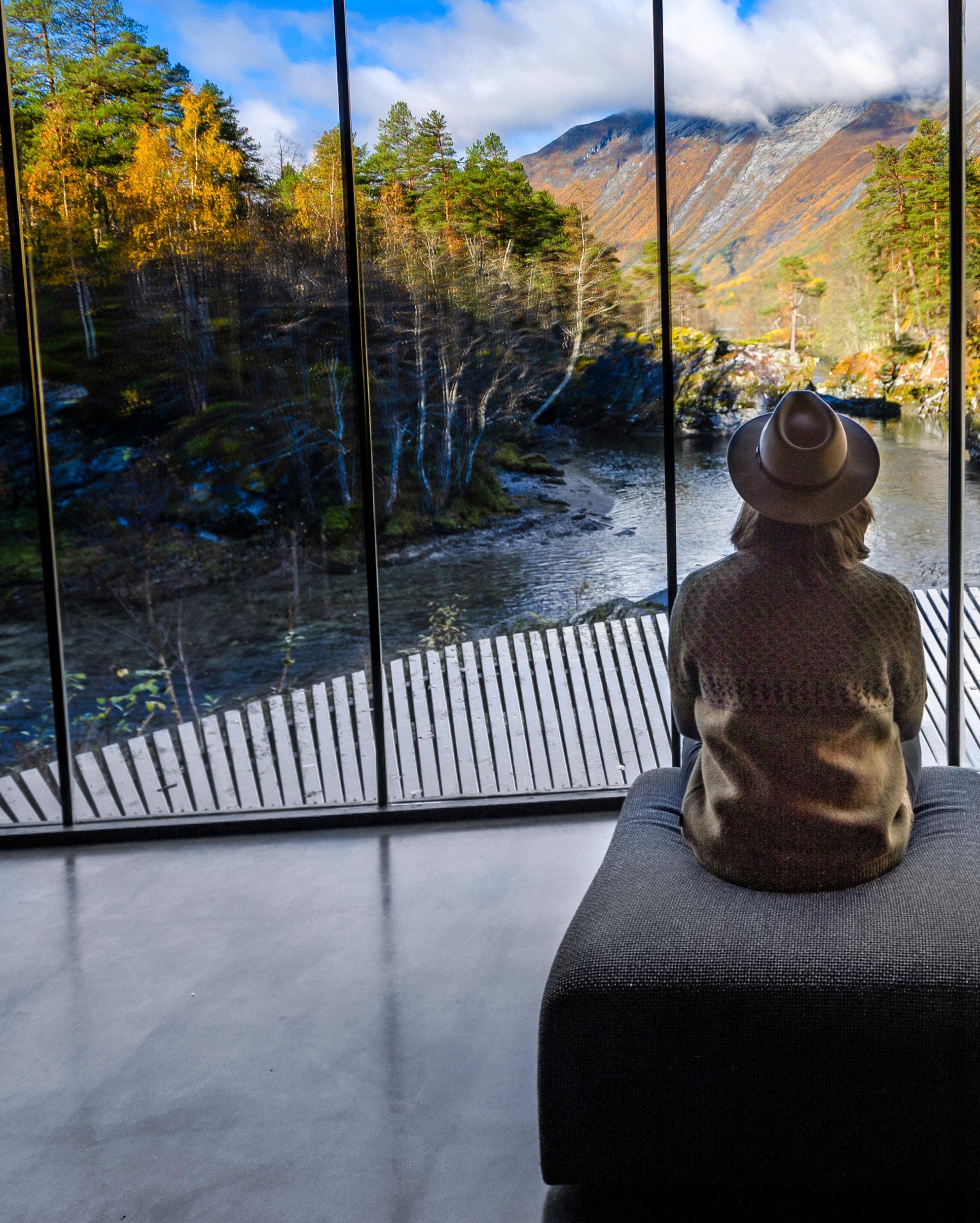
13 minute read
SUSTAINABILITY STORIES
THE RISE OF THE ECO-FRIENDLY TRAVEL INFLUENCER
Questioning the responsibility of influencer culture to encourage eco-friendly travel and drive positive change with Founder of TheTravelBook, Rasmus Lythcke
Writer: Phoebe Harper
PHOTO BY THETRAVELBOOK
If Instagram, TikTok, and YouTube are anything to go by, the life of a travel influencer seems dreamworthy. To many, the idea of throwing in the nine-to-five to devote your time to the pursuit of your own wanderlust is undeniably seductive.
Rasmus Lythcke, Founder of TheTravelBook – a blog and social media platform with an Instagram following of over 30,000 people – was one such individual.
“I wanted to live this life that I saw everywhere on social media. The lifestyle of a travel blogger looked so beautiful,” he tells us.
After 10 years spent working in marketing and branding for the travel industry, Lythcke had begun to clock up some serious air miles. Commuting between his hometown of Copenhagen, his workplace in Zurich, and visiting his partner in New York, he estimates this amounted to roughly 100 flights a year.
“I was spending more time in airport lounges than in my own apartment!”
With his partner and co-Founder of TheTravelBook Karoline fully onboard, together the couple embarked on a major lifestyle change and cashed in on a one-way ticket to Southeast Asia to pursue the travel influencer dream.
“We were living as kings and queens, and it was too good to be true,” he recalls. “After a few months, we slowly started to build our social media following. With that, we recognised that we were developing a kind of responsibility towards people.”
It may be easy to produce an aesthetically friendly grid on Instagram, but what you don’t see is the environmental cost behind each picture, like the carbon emissions of the transport and flights involved just to capture one shot.
It is this idea of responsibility, as Lythcke, and indeed the world, began to awaken to an environmental and social conscience, that has come to define TheTravelBook’s success and content offering, as a platform entirely dedicated to sustainable travel and eco-friendly lifestyle tips.
For the globetrotting duo, this began with searching for accommodation and restaurants that would most benefit local communities, avoiding the model of tourism that is designed to cater to the whims of the Western world.
“There’s always white people sitting in westernised countries, earning from all these people running 100 kilometres an hour to fulfil the tourists’ needs,” Lythcke comments.
It also meant avoiding air travel as much as possible and becoming creative with more eco-friendly means of transportation. Ironically, ever since becoming a full-time travel influencer, Lythcke has only taken one flight in the past three-and-a-half years.
Four years since its inception, TheTravelBook has just been nominated as Denmark’s Best Travel Blog 2022. Copenhagen itself, where Rasmus and Karo are based, is widely hailed as the Green Capital of the World, with Denmark often ranking amongst the top positions in the Global Sustainability Index largely due to its innovative stance on waste management.
The whole idea behind TheTravelBook is to inspire people to travel without compromising on either quality, luxury, or enjoyable holiday experiences, whilst maintaining an eco-friendly lifestyle.
“Even going back to when we started, social media was entirely different. Then, if you were talking about sustainable tourism, that basically meant you had to walk around naked in a forest, eating leaves and not breathing before it was sustainable!
“But now, we have been doing this for years, and I’ve never once felt like I’ve had to compromise.”
Norway - Atlantic Ocean Road

CALLING FOR A CULTURE SHIFT
Social media influencers are a modern-day phenomenon with the potential to impact the entire tourism industry in shaping consumer behaviour.
Often with devoted, mass followings, Lythcke recognises that such individuals need to be mindful of the kind of tourism behaviour they are promoting. Having such an influential platform at your fingertips provides a powerful opportunity to become an ambassador for positive, ethical change.
“In my opinion, travel influencers have the biggest responsibility in making sure they’re not acting in the wrong ways,” he says.
He remains highly critical of influencer culture, as a world that can be built on artificial images and meaningless claims, particularly in an age where “sustainability has become the biggest buzzword of our time.”
As more and more people jump on to the trend of claiming sustainability, the true meaning of the word is diminishing, reducing its essence to nothing more than an empty hashtag to justify what in effect may represent the opposite of the word’s definition.
“It’s easy to see when someone is trying to force themselves into a topic that is outside of their comfort zone,” he says, laughing at how you will often see influencers dressed in a bikini made from recycled bottles claiming to be sustainable, having
PHOTO BY THETRAVELBOOK
jumped on a long-haul flight for a short-term stay in Thailand at the expense of whatever hotel might be hosting them.
“It’s extremely difficult not to be dragged into it when so many things claim to be sustainable, but you have to follow this up with a lot of research to make sure that things genuinely are being done in an eco-friendly way. Transparency is key and ensures that you’re authentic and actually doing what you believe in by travelling sustainably.”
TRANSPARENT AND AUTHENTIC CONTENT
Behind every stunning photo or travel guide that TheTravelBook posts, are the invisible hours of research that have been put in to planning that trip or selecting that particular hotel or restaurant.
“Before I arrive at any destination, I will spend hours and hours doing research in advance. This way, when people arrive at our social media pages, the research has already been done for them,” Lythcke explains.
By so doing, reliable means of sustainable travel are placed easily within reach for a mass audience. As such, the role of the influencer becomes far more educational and informative, exceeding the traditional model of providing aesthetic, ‘like’friendly content.
“I try to make it easier for everyone by giving them travel inspiration, where they don’t have to think about the research behind it.”
This research is often shared in the most transparent way through dedicated posts on the blog, where Lythcke might share a calculation of the carbon footprint behind an entire itinerary as accurately as possible.
For each trip, this revolves around the three essential pillars of travel – transport, accommodation, and gastronomy.
A slow-travelling couple, TheTravelBook limit themselves to
no more than one flight per year. As official brand ambassadors for BMW, their preferred means of travel is electric vehicles (EVs), alongside rail travel.
Lythcke is also a huge advocate for bringing back the romance of the road trip, where the drive to get there is an integral part of the holiday itself.
“Transportation should become part of the journey where it’s not just about being in the car or on the train. Change your mindset to be glad that you’re able to discover a lot more than you would if you were just going from airport to airport.
“I thought that not travelling in aeroplanes twice a year would kill me. But if I’m able to make this change, people who are going on regular holidays maybe just twice a year can do the same.”
In terms of accommodation, Lythcke recommends researching options that have been vetted by reliable sources for their sustainability credentials, such as Green Key International - the leading standard for excellence in the field of environmental responsibility and sustainable operations within the tourism industry.
“If you also want to support sustainable tourism, book directly through the owner rather than through huge booking chains like Booking.com. This removes all the fees that you’d be giving to a larger booking group - which is likely to be a company that doesn’t need any more money!
“Even if you do find a price that’s more competitive on a site like that, it’s always worth discussing with the owner directly to see if they would be willing to match it. Support the hotel owners themselves as best as you can.”
This ties into the third essential pillar of gastronomy, and how what we consume can impact the local economic footprint, for example by choosing restaurants and eateries that prioritise seasonal and locally produced products. Travellers should feel confident to ask for recommendations to eat where the locals eat, rather than opting for the obvious tourist restaurants which rely on international ingredients regardless of seasonality.
“Eating in local spots doesn’t just benefit the restaurant, it also benefits the local farmers behind the produce, or the fishermen who bring in that catch every morning. Go for the locally, freshly caught fish and support whatever local producers you can.”
Next up, TheTravelBook will be hitting the road (in an EV, naturally) through Sweden and on to the Fjords of Norway, documenting their travels as they go and continuing to act as ambassadors for a more ethical, mindful lifestyle.
“The important part all along, is that we still want to inspire people to travel.”
Visit @thetravelbook or TheTravelBook to find out more.

Tell us your story and we’ll tell the world.
Outlook Travel Magazine is a digital and print publication aimed at business executives and avid travellers, reaching an audience of more than 575,000 people. Working closely with tourism boards and associations around the globe, from cities to regions, from countries to continents, we take an in-depth look at where to visit, where to stay and what to do when you are there.
With original and exclusive content compiled by our experienced editorial team, complemented by an in-house design and production team ensuring delivery to the highest standards, we look to promote the latest trends, blogs, reviews and success stories from this fast-moving industry.

You can join the vast numbers of tourism sector players enjoying the exposure we provide across our digital platforms with a range of options, from advertising through to free-of-charge editorials, extensive social media saturation, enhanced B2B networking opportunities, and a readymade forum to attract new investment and increase exposure.
To get involved, please contact Outlook Publishing’s Managing Director, James Mitchell, who can provide further details on how to feature your company, for free, in one of our upcoming editions.
ISSUE 09
TURKS AND CAICOS ISLANDS
TRAVEL GUIDE
FREE Marketing Opportunity
TURKS TRAVEL GUIDE AND CAICOS ISLANDS

FEATURE: SUSTAINABILITY STORIES
The rise of the eco-friendly travel influencer
TRAVEL GUIDE: CHARLESTON
The heart of the Lowcountry
TURKS AND CAICOS ISLANDS
TURKS AND CAICOS ISLANDS
Escape to the world’s best kept secret
Savour a slice of paradise and recalibrate to the slow pace of island living in the exclusive archipelago synonymous with luxury tourism

Writer: Phoebe Harper | Project Manager: Krisha Canlas
Located to the southeast of the Bahamas, the Turks and Caicos Islands (TCI) is a paradisiacal archipelago comprising over 40 islands and cays – only nine of which are inhabited. These low-lying coral islands are said to host the bluest waters in the Caribbean and float serenely above the third-largest barrier reef in the world.
Boasting the undeniable magnetism of pristine swathes of icing sugar sand, fringed with gently swaying palm trees and temperate azure waters that are the gateway to a thriving marine realm, it comes as no surprise that beaches and a heavy dose of ‘Vitamin Sea’ are the main draws for those visiting TCI, compared to its flashier and more developed Caribbean island neighbours. Nevertheless, the endless flurry of celebrities that choose TCI as their chosen getaway testify to the island chain’s status as a haven for luxury tourism.
Throughout TCI, you will be spoilt for choice with all-inclusive luxury resorts and tasteful villas designed for serenity and seclusion a stone’s throw from the ocean. It is this emphasis on luxury that naturally lends a certain exclusivity to TCI, meaning that any visitor is unlikely to encounter masses of tourists. Meanwhile, far-flung islets such as Ambergris Cay and Pine Cay, are private island
WHEN TO VISIT
Although the weather in TCI is favourable all year round, a popular time to visit is between April and May, when both prices and the number of visitors are likely to be lower. High season is generally considered as falling between December to March, making it a popular winter sun destination. The only month to avoid is September, when there are higher chances of hurricanes.
getaways home to hidden resorts.
As you may have guessed from the name, TCI is composed of two island groups. The larger cluster of the Caicos Islands chain to the west comprises Providenciales, North Caicos, Middle Caicos, East Caicos, South Caicos, and West Caicos, whilst the smaller Turks Islands of Salt Cay and Grand Turk lie to the east. Although Providenciales represents the modern-day hub of tourism in TCI, the historic centre of Cockburn Town on Grand Turk is the cultural and historic capital, where you will find colonial-style mansions, and a National Museum boasting spoils from centuries-old shipwrecks that have fallen prey to the surrounding reefs.
In terms of wildlife, TCI is a haven for migrating humpback whales and is reputed as one of the world’s best destinations for whale watching. Turtles and dolphins are other staples of marine life here. If joining a boat tour, you may be blessed with an appearance from the local celebrity and national treasure – Jojo, the wild bottlenose dolphin known for his naturally playful interactions with passers-by.
Wildlife enthusiasts will marvel at TCI’s expansive selection of national parks, nature reserves and sanctuaries, all of which are protected areas. Alongside a whole host of other natural delights, spot endemic rock iguanas on Little Water Cay, otherwise known as Iguana Island, or observe a vibrant flamboyance of flamingos on the salt Salinas of South Caicos.
Elsewhere, wild donkeys abound, many of whom are descendants from the animals that were originally used in the heyday of salt production across the islands, supposedly brought here by Bermudians to pull carts across the salt flats. It is not uncommon to see them wandering the streets freely, especially in Grand Turk.
Whilst the flora and fauna of the islands are the real calling card, TCI is a land ripe with culture and history for those interested in peeling back the layers of this fascinating destination. Its cultural legacy extends far beyond colonialism, to when these shores were inhabited by the Taino and Lucayan Indians before Christopher Columbus set foot on Grand Turk in the late fifteenth century during his discovery voyage of the “New World”.
These shores are ripe with romantic tales of piracy and smuggling, transporting you back to bygone centuries when these islands and cays were the playground of pirates lying in wait to target Spanish treasure galleons. Some claim that the word ‘Turk’ behind the islands’ name hearkens back to this time, as a term that translated as pirate during the days of the Ottoman Empire. However, the popular local interpretation is that TCI refers to the indigenous Turk’s Head ‘Fez’ cactus, and the name ‘Caicos’ – from the Lucayan term ‘caya hico’, meaning chain of islands.
TCI’s cultural legacy is tangible in the local cuisine, with a fondness for shellfish, conch in particular, being passed down through the centuries. Indeed, TCI hosts the world’s only commercial conch farm. Other seafood delights can be enjoyed on a weekly Thursday-night traditional fish fry, where you can taste the Jamaican influence with generous sprinklings of Cajun and jerk seasoning. TCI’s culinary delights are best washed down with a locally brewed rum such as Spicy Gosling, or a glass of the local favourite Turks Head Beer.
Each island in TCI is a destination of its own, with a different feel and unique offering depending on your preferences. With almost 40 separate islands to explore, TCI will keep you coming back for more.
Having photographed every continent on Earth, we take a deep dive into the evocative work of Philip Lee Harvey
30 | Outlook Travel issue 09 Outlook Travel issue 09 | 31
www.outlooktravelmag.com/work-with-us









